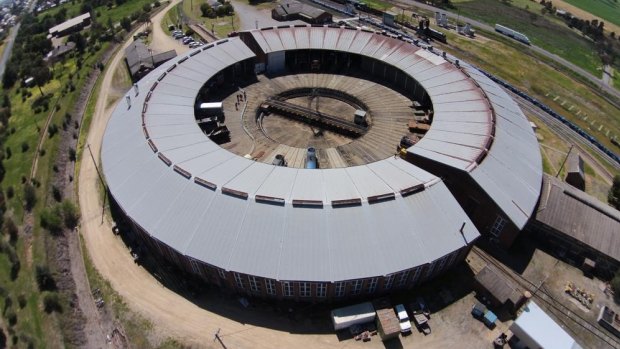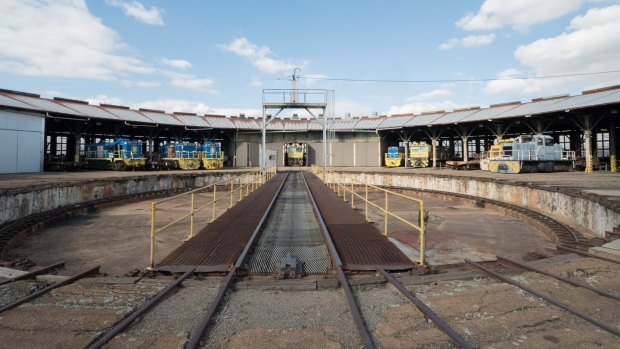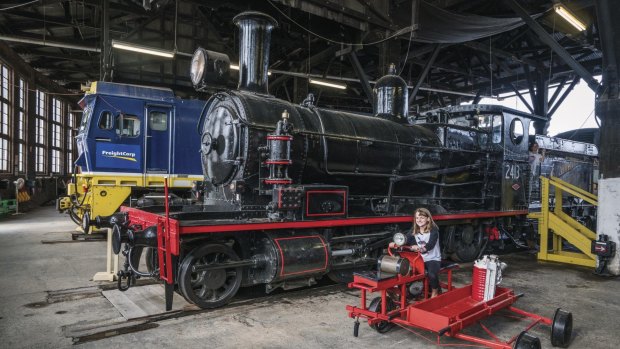This was published 3 years ago
Junee Roundhouse Railway Museum: Australia's biggest turntable spins trains, not records
By Rob McFarland

Turn, turn, turn: Roundhouse Railway Museum in Junee.
Unless you're a rail enthusiast, the thought of visiting a railway museum might not fill you with heart-thumping excitement. It certainly didn't for me. But I'd challenge anyone not to be charmed by the nostalgic glimpse of yesteryear offered by the Roundhouse Railway Museum in Junee.
Located roughly halfway between Sydney and Melbourne, the facility was the last steam locomotive depot built by the NSW Government. Forty-two covered repair bays fan out like spokes from a 30.5-metre turntable, which was the largest in the southern hemisphere when it opened in 1947.
Today, 13 of the bays are taken up by the museum while the rest are used by the Junee Railway Workshop for commercial repairs and reconditioning. If you visit during the week, you may even get to see the turntable in action as trains are manouevred between bays.

Forty-two covered repair bays fan out like spokes from a 30.5-metre turntable, which was the largest in the southern hemisphere when it opened in 1947.
Vince Hollis is one of several volunteers who work at the museum. A former station master and train controller, he's witnessed the dizzying leaps in technology that have taken us from steam-powered trains to diesel and electric.
Inside the museum, he shows me the hand-drawn graphs he used in the 1980s to oversee train movements before computerisation. Stations would phone in departures and he'd update the graphs accordingly, moving slower trains into sidings to allow faster ones to pass. Services were supposed to run to a timetable but it didn't always go to plan.
"Occasionally a train would lose some time and you'd find out later that the driver had stopped to pop into McDonald's," he recounts with a smile. "Or a driver would pull over to pick mushrooms and the passengers would jump off to get some too."

Interestingly, all but two of the trains were built in Australia, with several constructed at the Eveleigh Workshops in Redfern. Credit: Destination NSW
Outside in the roundhouse, we look through the museum's impressive collection of trains and rolling stock, most of which has been donated by the government.
Exhibits range from a "tin hare", a compact passenger train commonly seen on branch lines between the 1930s and 1980s, through to a 162-tonne 36 class steam locomotive, which was used to haul passenger trains around the state until the 1960s.
Interestingly, all but two of the trains were built in Australia, with several constructed at the Eveleigh Workshops in Redfern. The exceptions are a gleaming black steam locomotive built in Glasgow in 1891 and a hulking great US steam crane used for derailments that could lift a staggering 50 tonnes.
Inevitably, the museum attracts its fair share of purists, who relish pointing out that the wrong kind of screw has been used in a repair. But it also gets lots of families and is particularly popular with grandparents and grandkids.
While the trains and the turntable are undeniably impressive, it's the insight into a simpler, less-frantic era of travel that is so compelling.
In the '40s and '50s, people in regional areas relied on trains to get around. Drivers knew the families that lived along their routes and would slow down to pick them up. Locomotives chugged around the state in whistling clouds of steam. Mail trains still collected post from stations and sorted it on board overnight.
Of course, all this misty-eyed nostalgia glosses over the lack of modern conveniences such as air-conditioning and heating. Plus, you'd probably be late because the driver had stopped to pick mushrooms for his tea. Nevertheless, it's a fascinating snapshot of how transport and society has changed over the last 100 years.
DETAILS
VISIT
92 Harold St, Junee, NSW. Open Wednesday to Sunday, 10am to 3pm. Family $16, adult $6, concession $4. Phone 02 6924 2909 or see roundhousemuseum.com.au
MORE
traveller.com.au/new-south-wales
Please note: Due to COVID-19, travel restrictions currently apply to some of Australia's borders and Sydney residents are discouraged from travelling to regional NSW. See Tourism Australia's travel status map for current restrictions.
Rob McFarland was a guest of Destination NSW.
See also: Return of The Ghan: One of the world's greatest train journeys is back
Sign up for the Traveller Deals newsletter
Get exclusive travel deals delivered straight to your inbox. Sign up now.